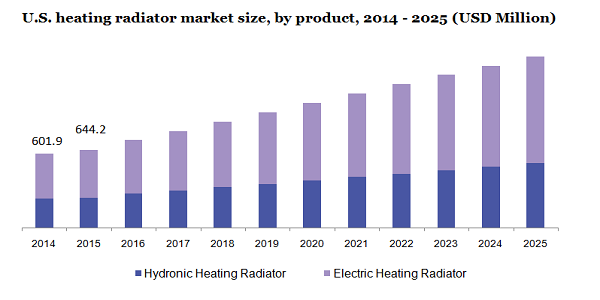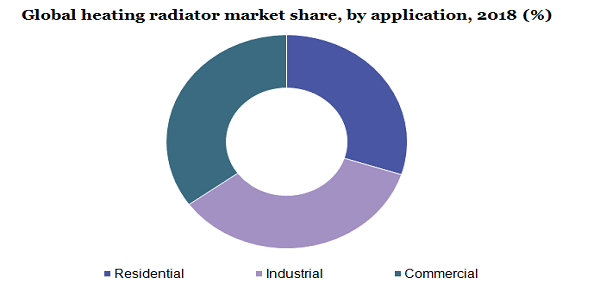- US: +1-408-610-2300
- Toll Free: +1-866-831-4085
- Become a Client
The global heating radiator market size was accounted for USD 5.1 billion in 2018 and is projected to grow at the CAGR of 8.8% over the forecasted period, 2019 to2025. Rising demand for heating solutions with high energy efficiency especially in residential areas is projected to increase the demand for the product in the next few years.
Moreover, the increasing need for advanced or updated equipment is projected to contribute to market growth. Electric-type heating radiators are anticipated to dominate the market during the forecast period.

In addition, the development in robotics & automation, different weather conditions, and demand for high energy-efficient products are expected to propel the demand for heating radiators. Moreover, rapid industrialization with the need for renovation and repair is anticipated to boost the market growth.
Furthermore, a rise in the demand for space warming equipment with greater energy efficiency is also expected to surge the growth of the radiator industry. Growing consumer awareness regarding energy saving in industrial and residential sectors is expected to positively impact the growth of the heating radiators market.
The manufacturers focus on continuous development and technological innovation to meet customer needs. Moreover, a high number of local players are representing tough competition to global players. Additionally, the companies face challenges due to the increasing demand for skilled labor and the volatility in raw material prices.
The residential segment is expected to lead the U.S. market. Residential applications comprise homes, multi-family homes, etc. Electric radiators are anticipated to contribute to the largest market share. Electric radiators are expensive than hydronic radiators and offer better performance, low maintenance. These key factors are projected to spur segmental growth.
In hydronic radiators, hot water is pumped in-floor tubing and is utilized by the heat exchanger to make it warm. The hydronic radiator is considered to be safe and it does not blow any air which is harmful to the respiratory system. Additionally, the hydronic radiator is cheaper than an electric radiator. The hydronic radiators segment is projected to grow at a CAGR of 7.4% over the forecasted period.
The electric radiator is highly energy-efficient, and it does not use any fuel or oil. Thus, these radiators are expected to dominate the market in the next few years. The electric radiator segment is anticipated to account for USD 5.4 billion by the end of 2025.
Depending on the application, the heating radiator market is divided into industrial, commercial, and residential applications. The growing consumer emphasis on infrastructural repair and renovation especially in the construction sector is expected to propel the demand from residential applications.

In the commercial sector, the growing need for heating radiators in offices, shops, and spaces is expected to support the market growth. In 2018, the industrial segment was accounted for USD 1.8 billion in the overall market. The product is widely used across manufacturing, mining, beverages, and aviation industries.
In 2018, Asia Pacific led the market with the highest market share of around 29.4% in the overall market. It is projected to grow at a CAGR of 10.9% during the forecasted period. Rising construction activities across emerging countries such as India and China are expected to positively impact the market growth.
Europe is estimated to expand at a CAGR of over 8.4% from 2019 to 2025. Moreover, changing weather conditions, and increasing demand for the energy-efficient product is anticipated to drive the market growth. Product development owing to technological advancement for better performance in heating applications is projected to foster market growth in the region.
Coronavirus outbreak has caused the shutdown of manufacturing units across the globe. In the Asia Pacific, China and India have been impacted heavily owing to supply chain disruption in the manufacturing of heating equipment such as radiators and exchangers. Lockdown and closedown of international borders have caused delays in the trade/shipment of heating radiators across the countries.
Manufacturing companies across Europe, and China are still working at 50% of total capacity. However, the long-term impact of the coronavirus pandemic is projected to be negated by the normalized business operation.
Leading players in the market include Vasco Group; KORADO, a.s.; Runtal North America, Inc.; U.S. Boiler Company, Inc.; PURMO; Stelrad Limited; Nuociss; Zehnder Group UK Ltd.; H2O Heating Pty Ltd.; IRSAP; Polytron Technologies Inc.; Florence (Beijing); and Hunt Heating.
Companies in the market invest heavily in R & D activities, new product development to increase their sales across the globe. Some of the players focus on strategic acquisitions to gain an edge over other players.
|
Attribute |
Details |
|
The base year for estimation |
2018 |
|
Actual estimates/Historical data |
2014 - 2017 |
|
Forecast period |
2019 - 2025 |
|
Market representation |
Revenue in USD Million, & CAGR from 2019 to 2025 |
|
Regional scope |
North America, Europe, Asia Pacific, South& Central America &Middle East & Africa |
|
Country scope |
U.S., Canada, Germany, France, Russia, U.K., China, Japan, Australia, India, Brazil, Argentina, UAE, and Saudi Arabia. |
|
Report coverage |
Revenue forecast, company share, competitive landscape, growth factors, and trends |
|
15% free customization scope (equivalent to 5 analyst working days) |
If you need specific information, which is not currently within the scope of the report, we will provide it to you as a part of the customization |
This report forecasts revenue growth at global, regional, and country levels and provides an analysis of the latest industry trends and opportunities in each of the sub-segments from 2014 to 2025. For the purpose of this study, Million Insights has segmented the global heating radiator market report on the basis of product, application, and region:
• Product Outlook (Revenue, USD Million, 2014 - 2025)
• Hydronic Heating Radiator
• Electric Heating Radiator
• Application Outlook (Revenue, USD Million, 2014 - 2025)
• Residential
• Industrial
• Commercial
• Regional Outlook (Revenue, USD Million, 2014 - 2025)
• North America
• U.S.
• Canada
• Europe
• Germany
• France
• Russia
• U.K.
• The Asia Pacific
• China
• Japan
• Australia
• India
• Central & South America
• Brazil
• Argentina
• Middle East &Africa (MEA)
• UAE
• Saudi Arabia


Research Support Specialist, USA